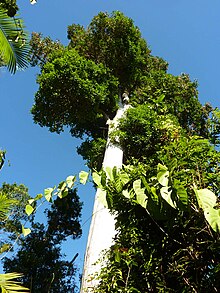Syzygium alliiligneum
| Syzygium alliiligneum | |
|---|---|

| |
| Syzygium alliiligneum near Mission Beach, Queensland | |
| Scientific classification | |
| Kingdom: | Plantae |
| Clade: | Tracheophytes |
| Clade: | Angiosperms |
| Clade: | Eudicots |
| Clade: | Rosids |
| Order: | Myrtales |
| Family: | Myrtaceae |
| Genus: | Syzygium |
| Species: | S. alliiligneum
|
| Binomial name | |
| Syzygium alliiligneum Hyland, 1983
| |
Syzygium alliiligneum is a species of plant in the Myrtaceae family. Common names include Mission Beach satinash, onionwood, puddenwood, bark in the wood, roly poly, and watergum.[1]
Description
Large rainforest tree, up to 30 metres (98 ft) in height; grey bark, cream-colored flowers and abundant small (40 by 35 millimetres (1.6 by 1.4 in)) red fruit. Species name from the Latin allium, for "garlic", and lignum, for "wood". Cross-section shows onion-like rings of bark in the timber.[1]
Distribution and Habitat
Endemic to North East Queensland, Australia, between Cape Tribulation and Tully, in lowland rainforest to 700m abl.[1]
Ecology
Fallen fruits are eaten by the southern cassowary, and are also edible by humans.
-
Fruit on the forest floor
-
Fruit soaking at nursery
References
Further reading
- Harrington, M. G., and P. A. Gadek. "Molecular systematics of the Acmena alliance (Myrtaceae): phylogenetic analyses and evolutionary implications with reference to Australian taxa." Australian Systematic Botany 17.1 (2004): 63-72.
- Orchard, A. Cyclone Tolerant, and At Ella Bay. "Cassowary Specific Revegetation."
- Cooper, William T., and Wendy Cooper. Australian Rainforest Fruits: A Field Guide. CSIRO PUBLISHING, 2013.
External links
- "Syzygium alliiligneum" at the Encyclopedia of Life
- Syzygium alliiligneum Factsheet
- The Australian Botanic Garden, Mount Annan entry


